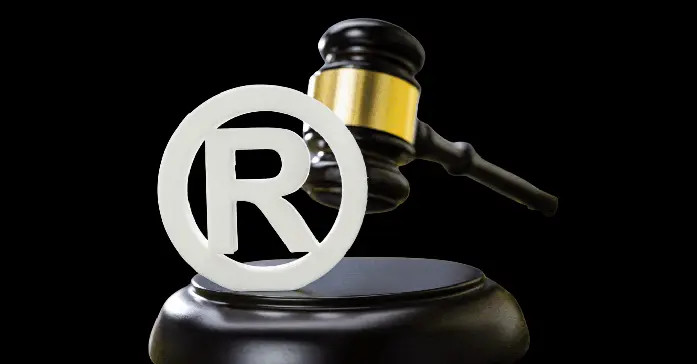
Our Expert consultation will help you to get the Trademark registration online seamlessly from the government.
Trademark Registration gives the owner an exclusive right to protect the Logo, Symbol, and Words as the identity of the Brand. To Protect your brand with our trademark registration services.
Kinds of Trademark Registration in India
The following are the kinds of trademark registration available in India-
Service mark
A service mark is comparable to a product mark representing a service rather than a product. The primary function of a service mark is to differentiate its proprietors from the owners of other benefits. Accordingly, trademark applications submitted under trademark classes 35-45 may be classified as service marks since they represent a service.
Marks in the Series
These are the marks that have been registered for usage before or after a chain of items that share a similar suffix, prefix, or symbol.
Mark of Sound
Access specialized resources and expert insights that strengthen your case and keep you informed on all legal matters.
Who Can opt for Trademark Registration
1
Any Individual Person
An individual person who is not currently in business can also file a trademark application and receive trademark registration for the brand name/device) that the applicant intends to use in the future.
2
Shared Ownership
A Firm’s joint proprietors can apply for a trademark together, and both of their names may be listed in the application.
3
Partnership Firm
When registering a trademark, a partnership business with a maximum of 10 members must include all partners' names in the application. In addition, if a minor partner is present, the name of the minor's guardian must be stated.
4
LLP (Limited Liability Partnership)
The application for the Limited Liability Partnership should be in the name of the LLP. It is a legal entity in which each participant has their own identity. Because the trademark belongs to the LLP, the partners cannot be applicants. The application must contain all the partners' names.
5
Indian Corporation
Any Indian firm, whether private limited, public limited, or any other type, must file a trademark application in its name. Because every incorporated organisation has its own legal body and identity, the director of a company cannot be a trademark applicant.
6
Foreign Corporation
If a foreign-incorporated firm files for a trademark in India, it must do so under the corporate name as it is registered in the foreign nation. The registration type, the government, and the law should all be indicated here. It must mention the Indian address from which they are running their business in INDIA.
7
Society or Trust
When filing a trademark application on behalf of a trust or society, the managing trustee, chairman, or secretary of the trust or society must be mentioned.
How we work?

Fill our Registration Form. Our assistant will call you.

We will search the class of your brand by trademark expert.

We will draft the authorization letter (Form-48)

Upload the Required Documents and make the payment.

Our experts will file the TM application

Congratulations now you can use TM next to your Brand Name
What are the Trademark Classes?
There are 45 trademark classes, and all goods and services are classified according to these classes. You must exercise extreme caution while selecting the classes since they will affect the validity of your trademark for your company's products/services. If your company sells various goods and services that fall into several classes, you must guarantee that you may file for a trademark under all of the appropriate classes.
In India, some of the most common trademark classes are:
- Class 9 consists of mobile software (App) and electronics.
- Readymade Clothing is included in Class 25.
- Class 35: involves business management and advertising, online retailing or wholesaling, e-commerce.
- Education and entertainment are included in Class 41.
Documents Needed for Trademark Registration

Applicant’s / Company Name
- Name of the applicant

Business Type
- Type of business

Business Details
- Nature of business (specific goods/services)

Brand/logo/slogan name
- Name of a brand/logo/slogan

Office / Business address
- Registrant's mailing address with PIN CODE.
The following documents are required:
- Form-48 has been signed. (Power of Attorney/Vakalatnama)
- Signatory identification evidence
- Proof of the signatory's address
- Business validation (depends on the type of business)
- MSME registration certificate/Udyog Aadhar (optional)
A trademark is a distinct identity that distinguishes your organisation, product, or service from the competition. A registered trademark is the intellectual property/intangible asset of your company. It safeguards your investment in building client trust and loyalty.
Registration of a trademark gives you the ability to sue anybody who attempts to replicate your trademark and prohibits others from using an identical trademark to the one you registered.
Online Procedure of Trademark Registration
The online procedure of trademark registration involves the following steps:
Search for The Brand Name
Choosing a different and offbeat brand name is a sensible choice because most generic names are already in the hands of someone. Furthermore, settling on a name necessitates a rapid research procedure to guarantee that you are not selecting a brand name that is already in use. The best thing is that you may develop a distinctive brand name by inventing or coining some phrases and combining them with generic terms.
Putting up a trademark application
The following supporting papers must be presented with the application for online trademark registration:
- Business Registration Evidence: Based on your registered business (for example, sole proprietorship, etc.), you must produce identification proof of the company's directors as well as address proof. In the case of a firm, the address evidence of the company must be presented.
- The proposed mark's proof of claim (if applicable) can be utilised in another nation.(sales invoices mentioning the brand name)
- The applicant must sign a power of attorney (Vakalatnama)
Submitting a brand name registration application
The two methods for filing the registration application are manual filing and e-filing (form TM-A). If you select manual filing, you must personally transport and hand over your application for registration to the Registrar Office of TradeMarks in major Indian cities such as Delhi, Mumbai, Kolkata, Ahmedabad, and Chennai. Following that, you must wait at least 15 -20 days to receive the acknowledgement. In the event of an e-filing system, however, you will immediately obtain your receipt of acknowledgement on the government website.
Examining the procedure of the brand name application
Once the application is submitted, the Registrar of Trademarks will review it to see if you fulfilled specific requirements and if your brand name fits with current legislation. Furthermore, there must be no similarity (visual or phonetical) of identity with any existing brand which is pending for registration.
Publication of your trademark in the Indian Trade Mark Journals
Following the examination procedure, if there is no objection raised by the registry (the stipulated time period may vary), the Registrar of Trademarks will accept and publish the brand name in the Indian trademark journal. This is perhaps the most crucial aspect of trademark registration. Within 4 months from the date of publication in the journal, any third party can oppose the instant application if there are any similarities between their brand name and the brand name in question. If within that time period no opposition is filed, the Registrar of Trademarks will issue the Trademark Registration Certificate.
Opposition to a Trademark
Suppose a third party files an objection within four (time period may vary) months of the trademark's publication in the trademarks journal. In that case, the Registrar of Trademarks will provide you with a copy of the opposition notice. You must respond to the opposition notice within 2 months by filing a counter-statement. If the counter statement is not submitted within two months, the trademark application will be regarded as abandoned and refused. In case of both the Notice of opposition and Counter statement the government fee of Rs. 2700 is to be paid by both the parties while filing.
However, suppose no objection is filed within three months. In that case, this procedure will not apply to you, and your brand name will be accepted for issuing a Trademark Registration Certificate.
Trademark Opposition Hearing
This procedure does not apply to you if there is no such trademark opposition in your case.
Suppose a third party contests your trademark, and you respond within two months. In that case, the Registrar of Trademarks will send a receipt of your response to the third party opposing trademark registration.
You and the third party must produce evidence in support of your claims. Following the filing of evidence under Rule 45, the Registrar will hold a hearing for you and the third party. You may submit your evidence under rule 46 or a notice intimating the registry that you will be relying upon the counter statement which has already been filed by you. The Registrar will issue an order accepting or rejecting the trademark application after hearing both parties and examining the facts. If the Registrar of Trademarks accepts your trademark application, he will proceed with the registration procedure.
The Issuance of a Trademark Registration Certificate
The Registrar will approve your trademark application if there's no objection being raised within the time period which may vary or on acceptance of your trademark application following a trademark opposition hearing. Wow! And the best moment for you would be when the Registrar issues the Registration Certificate with the Trademark Registry stamp. You can use the registered trademark sign (®) beside your brand name as soon as you get your certificate.
Steps Involved in The Plan of Trademark Registration
There are some steps involved in the plan of trademark registration-
Exceptional Rights
The registered trademark owner has complete control over it. The owner may use the same trademark for all other items that fall within the designated class(es) in the application. Furthermore, the proprietor owns the trademark and can prohibit others from using it in the class(es) in which it is registered. It also gives the owner the ability to sue for any unauthorised violation.
Increases Trust and Loyalty
Trademarks signify a product's or service's reputation and quality. Registering a trademark increases client confidence and recognition in the market. Furthermore, it contributes to the establishment of loyal and long-term customers who will continually choose your trademarked brand over others.
Selection of a Trademark
Remember to select a unique and distinct mark to represent your organisation. Another critical aspect is determining which class you belong to. There are now 45 kinds of products and services for which a trademark can be registered. Classifications 1–34 are for products, whereas classes 35–45 are for services.
Search for The Mark
Once you've decided on a mark, you should run a search to see if it's comparable to an already registered mark. You may do this yourself by visiting the Controller General's website for Patents, Designs, and Trademarks. A public search option is available on the website. After selecting this option, you must select your class and search the online database.
Application Submission
You can file a single application for several classes, series, or collective trademarks. Form TM-A must be completed for this. This form allows you to register your trademark in more than one class. This form has two distinct cost brackets:
- 9,000 rupees or 10,000 rupees If you are not a start-up, small business, or individual, you will fall into this category. You must pay Rs. 9,000 if you register the form electronically, or Rs. 10,000 if you file the form in person with the Office of TradeMarks.
- 4,500 rupees or 5,000 rupees This category includes individuals, small businesses (with MSME), and new businesses. The fee for e-filing the form is Rs. 4,500, or Rs. 5,000 if you file the form in person.
Make cautious not to make any mistakes when filling out the form since this may result in delays or even rejection of the application. You must fill out all the requirements and provide an image of the trademark with 9 by 5 cm dimensions. You may be needed to submit five copies of the same document. When filing, the whole file must be supplied with two duplicates.
Vienna Codification Procedure
The Vienna Categorisation, often known as the Vienna Codification, is an international classification of trademark sign components created by the Vienna Agreement (1973). Following the Trademark registration application filing, the Trademark Registrar will file the Vienna classification to the Trademark established on the marks' figurative components. Accordingly, the trademark application status is normally indicated as "Sent to Vienna Codification" while this work is being done.

The importance of trademark registration in India is as follows:
Use of the ® Symbol
When your trademark is registered, you may use the ® sign in your logo to show that it is a registered trademark & that no one else may use a similar brand. If another individual uses your trademark without your permission, you can sue in court for such obvious infringement of your exclusive usage rights.
Increases Trust and Loyalty
Trademarks signify a product's or service's reputation and quality. Registering a trademark increases client confidence and recognition in the market. Furthermore, it contributes to the establishment of loyal and long-term customers who will continually choose your trademarked brand over others.
Exceptional Rights
The registered trademark owner has complete control over it. The owner may use the same trademark for all other items that fall within the designated class(es) in the application. Furthermore, the proprietor owns the trademark and can prohibit others from using it in the class(es) in which it is registered. It also gives the owner the ability to sue for any unauthorised violation.
Protect Against Infringement
If someone uses a trademark without the owner's permission or in a deceptive manner, the owner can get an injunction to prevent the individual from using the brand without permission. In addition, your trademarked logo may not be used by anyone else, including rivals.
Product Differentiation
Customers can quickly locate your items if you register your trademark. It separates your goods or service from the competition while acting as an efficient advertising tool. Furthermore, your trademark or logo communicates your organisation's vision, quality, and uniqueness.
Creating Assets
The registration of a trademark grants a corporation intellectual property. A registered trademark is a legal right that may be purchased, assigned, franchised, or economically contracted. Furthermore, a trademark functions as an intangible asset on a company's financial sheet, providing all of the benefits associated with such assets.
Register your Trademark! Click Here

 251+ Experts are available
251+ Experts are available 
